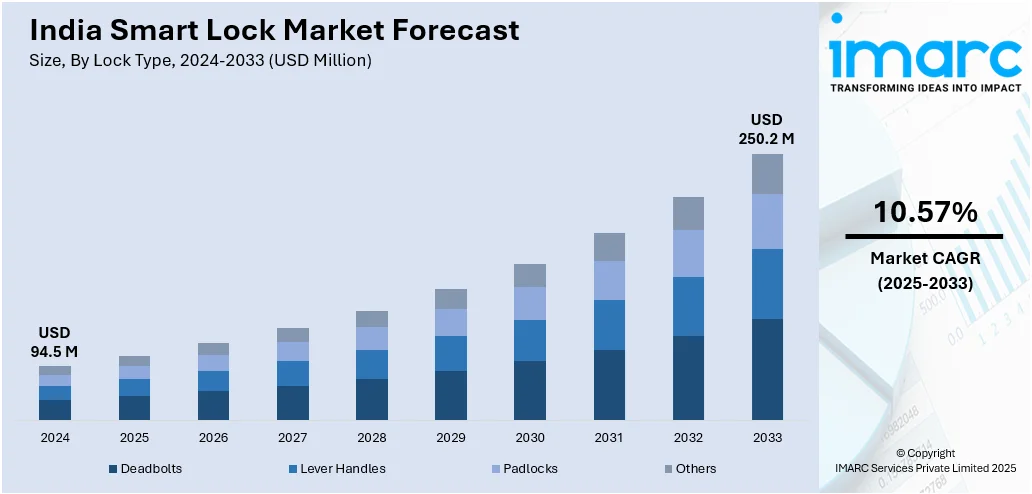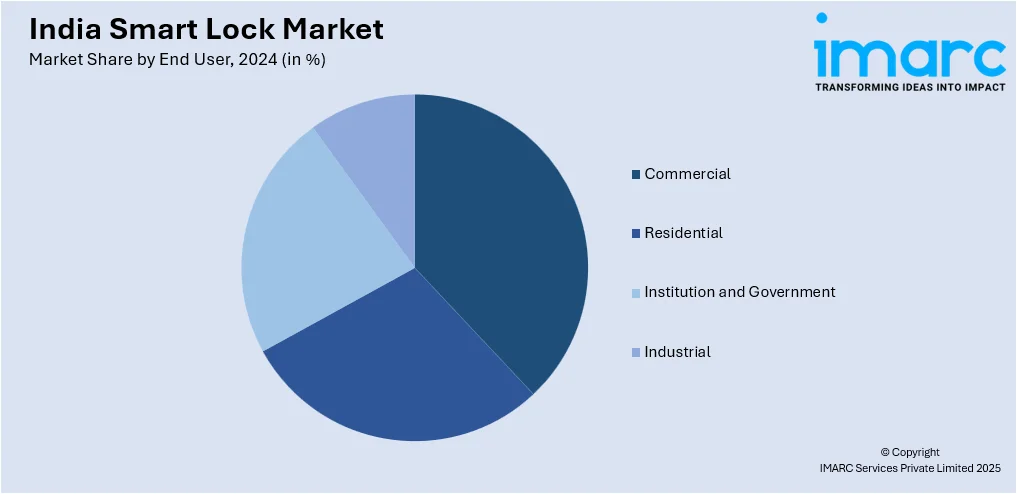
India Smart Lock Market Size, Share, Trends and Forecast by Lock Type, Communication Protocol, End User, and Region, 2025-2033
Market Overview:
The India smart lock market size reached USD 94.5 Million in 2024. The market is projected to reach USD 250.2 Million by 2033, exhibiting a CAGR of 10.57% from 2025-2033. The growth is primarily driven by the increasing demand for advanced security solutions and convenience offered by smart locks in both residential and commercial sectors.
Market Insights:
- On the basis of region, the market has been divided into North India, West and Central India, South India, and East and Northeast India.
- On the basis of lock type, the market has been divided into deadbolts, lever handles, padlocks, and others.
- On the basis of communication protocol, the market has been divided into Bluetooth, Wi-Fi, and others.
- On the basis of end users, the market has been divided into commercial, residential, institution and government, and industrial.
Market Size and Forecast:
- 2024 Market Size: USD 94.5 Million
- 2033 Projected Market Size: USD 250.2 Million
- CAGR (2025-2033): 10.57%
A smart lock represents a contemporary security innovation that elevates the control of access to physical spaces. Incorporating technology, it offers a convenient and secure means of entry. Users can remotely lock and unlock doors using smartphones, tablets, or other connected devices. Equipped with features like keyless entry, biometric authentication, and the provision of temporary access codes, smart locks empower users to efficiently manage access for themselves and others. Additionally, these locks seamlessly integrate into smart home ecosystems, facilitating automation. With its advanced security features surpassing traditional locks, the demand for smart locks is on the rise.

To get more information on this market, Request Sample
The smart lock market in India is experiencing a significant upswing, driven by the nation's increasing embrace of smart home technologies and a growing awareness of enhanced security solutions. In this country, the market is propelled by factors, such as the rising adoption of smart home ecosystems, increased smartphone penetration, and a growing emphasis on convenient yet secure access. One of the key drivers of the smart lock market in India is the convenience it offers through remote access control. Additionally, the elevating integration of features like keyless entry, biometric authentication, and temporary access codes further enhances the flexibility and security provided by smart locks. As India continues its digital transformation, smart locks are becoming an integral component of connected homes. These locks seamlessly integrate with other smart devices, allowing users to create comprehensive automation scenarios. Besides this, the advanced security features of smart locks, such as real-time monitoring and alerts, contribute to their popularity in a country where security concerns are paramount. Furthermore, the surge in urbanization and the increasing disposable income of the middle-class population in India contribute to the growth of the smart lock market. As consumers seek innovative and tech-savvy solutions to meet their security needs, the smart lock market is poised for sustained expansion in the coming years.
India Smart Lock Market Trends:
Growth Drivers and Opportunities in the India Smart Lock Market
India smart lock market share is witnessing huge growth in line with a mix of increased consumer demand for better security and the increased adoption of smart home technologies. In line with the rising disposable incomes of the middle class as well as urbanization, consumers are targeting easy-to-use, secure, as well as technologically advanced solutions such as smart locks for residences and commercial places. The increasing popularity of keyless entry, biometric verification, and remote control access has driven the growth of the market, particularly in residential and commercial markets. The high penetration of smartphones and the expansion of e-commerce sites also offer an expanded base of consumers for smart lock products. More increased consumer demand for connected home ecosystems should translate into smart locks, hence a more favorable India smart lock market outlook. The commercial segment is also an open one, with business establishments in quest of more efficient access control systems. Increasing smartphone and internet penetration in rural areas are turning out to be an untapped market for smart locks. This is complemented by government policies that target digitalization and infrastructure development, providing an enabling ecosystem for security solutions such as smart locks.
Challenges and Demand Shift of the India Smart Lock Market
Notwithstanding the encouraging growth of the India smart lock industry, a few issues may affect its future growth. One such significant hindrance, based on the India smart lock market statistics, is limited awareness and knowledge of smart lock technology among rural customers, where conventional security products are highly favored. Also, the initial high cost of smart locks when compared to traditional locking systems can be discouraging to some consumers, particularly in low-income groups. There are also questions about the security and reliability of these digital solutions, since some consumers may not trust IoT-based technology. With a change in demand, especially in urban markets, customers are seeking products that provide effortless compatibility with other smart home products, compelling manufacturers to innovate and adjust, according to the India smart lock market forecast. While premium smart locks with enhanced features are being adopted in urban markets, demands are also being made for affordable options in semi-urban and rural markets. The dilemma is to find a way to bridge the difference between price sensitivity and the desire for sophisticated security to make smart locks less of a luxury for many consumers.
India Smart Lock Market Segmentation:
IMARC Group provides an analysis of the key trends in each segment of the market, along with forecasts at the country level for 2025-2033. Our report has categorized the market based on lock type, communication protocol, and end user.
Lock Type Insights:
- Deadbolts
- Lever Handles
- Padlocks
- Others
The report has provided a detailed breakup and analysis of the market based on the lock type. This includes deadbolts, lever handles, padlocks, and others.
Communication Protocol Insights:
- Bluetooth
- Wi-Fi
- Others
A detailed breakup and analysis of the market based on the communication protocol have also been provided in the report. This includes bluetooth, wi-fi, and others.
End User Insights:

- Commercial
- Residential
- Institution and Government
- Industrial
The report has provided a detailed breakup and analysis of the market based on the end user. This includes commercial, residential, institution and government, and industrial.
Regional Insights:
- North India
- West and Central India
- South India
- East and Northeast India
The report has also provided a comprehensive analysis of all the major regional markets, which include North India, West and Central India, South India, and East and Northeast India.
Competitive Landscape:
The market research report has also provided a comprehensive analysis of the competitive landscape. Competitive analysis such as market structure, key player positioning, top winning strategies, competitive dashboard, and company evaluation quadrant has been covered in the report. Also, detailed profiles of all major companies have been provided.
Latest News and Developments:
- In May 2025, Qubo by Hero Group announced five new smart door lock models which includes Smart Door Lock Optima, Nova, and Alpha, as well as the 2025 editions of its best-selling models, Smart Door Lock Select and Essential. These innovative locks support various door thicknesses and heavy-duty security needs tailored for Indian consumers. The company also boosted its offline retail distribution network.
- In October 2024, MyGate expanded into the smart home ecosystem by launching a new range of smart door locks. The launches targeted consumer electronics with advanced smart security solutions designed for Indian homes. This move strengthened MyGate’s presence in the smart security market.
- In November 2024, Godrej & Boyce launched the Advantis IoT9 smart lock, featuring nine access modes including biometrics, NFC, Wi-Fi, Bluetooth, and RFID. It offers remote global access, voice guidance in multiple languages, and Alexa/Google Home integration. Godrej also rolled out its nationwide "Fear is Good" safety awareness campaign.
India Smart Lock Market Report Coverage:
| Report Features | Details |
|---|---|
| Base Year of the Analysis | 2024 |
| Historical Period | 2019-2024 |
| Forecast Period | 2025-2033 |
| Units | Million USD |
| Scope of the Report | Exploration of Historical Trends and Market Outlook, Industry Catalysts and Challenges, Segment-Wise Historical and Future Market Assessment:
|
| Lock Types Covered | Deadbolts, Lever Handles, Padlocks, Others |
| Communication Protocols Covered | Bluetooth, Wi-Fi, Others |
| End Users Covered | Commercial, Residential, Institution and Government, Industrial |
| Regions Covered | North India, West and Central India, South India, East and Northeast India |
| Customization Scope | 10% Free Customization |
| Post-Sale Analyst Support | 10-12 Weeks |
| Delivery Format | PDF and Excel through Email (We can also provide the editable version of the report in PPT/Word format on special request) |
Key Benefits for Stakeholders:
- IMARC’s industry report offers a comprehensive quantitative analysis of various market segments, historical and current market trends, market forecasts, and dynamics of the India smart lock market from 2019-2033.
- The research report provides the latest information on the market drivers, challenges, and opportunities in the India smart lock market.
- Porter's five forces analysis assist stakeholders in assessing the impact of new entrants, competitive rivalry, supplier power, buyer power, and the threat of substitution. It helps stakeholders to analyze the level of competition within the India smart lock industry and its attractiveness.
- Competitive landscape allows stakeholders to understand their competitive environment and provides an insight into the current positions of key players in the market.
Key Questions Answered in This Report
The smart lock market in India was valued at USD 94.5 Million in 2024.
The India smart lock market is projected to exhibit a CAGR of 10.57% during 2025-2033, reaching a value of USD 250.2 Million by 2033.
Major drivers of the India smart lock market are the growing need for home security solutions in the face of heightening urbanization, digitalization, and adoption of the Internet of Things (IoT) by consumers. The market is also driven by the increasing investments in smart home infrastructures, mounting preferences for touchless and app-based access controls, and improved safety features, driving overall India smart lock market expansion.
Need more help?
- Speak to our experienced analysts for insights on the current market scenarios.
- Include additional segments and countries to customize the report as per your requirement.
- Gain an unparalleled competitive advantage in your domain by understanding how to utilize the report and positively impacting your operations and revenue.
- For further assistance, please connect with our analysts.
 Request Customization
Request Customization
 Speak to an Analyst
Speak to an Analyst
 Request Brochure
Request Brochure
 Inquire Before Buying
Inquire Before Buying




.webp)




.webp)












